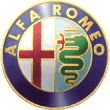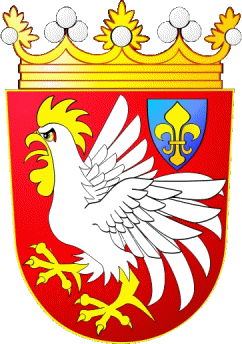
Guillaume (François, Antoine) Gallucio
de l'Hospital (1661-1704)
Marquis de
Sainte-Mesme
[ The famous rule governing the ratio of two vanishing functions was named after
him by
Johann Bernoulli
who discovered it during work-for-hire, surrendering naming rights! ]
[ The central picture above is copyrighted
and reproduced here by permission : © 2006
Jochen Wilke ]
François R. Velde provided us with the following blazon
of the puffed-up arms
used by the family of the mathematician, as listed
in Dubuisson 1757 (1:187):
Ecartelé au premier semé de France, au lambel de gueules de quatre pendants
(Naples);
au 2, d'or au lion de gueules enclos dans un double trêcheur
[fleuré-]contrefleuré du même (Ecosse);
au 3 parti burelé d'argent et de gueules
(Hongrie) et d'or à quatre pals de gueules (Aragon);
au 4, d'argent à la bisse
[d'azur, couronnée d'or, issante]
de gueules
(Milan);
sur le tout,
de gueules au coq d'argent crêté,
membré et becqué d'or,
accompagné
à senestre du chef d'un petit
écusson d'azur chargé d'une fleur-de-lis d'or (l'Hôpital).

Quarterly,
first Azure semy of fleur-de-lis Or, a label of four points Gules (Naples);
second Or, a lion rampant Gules within a double tressure flory-counterflory of the same
(Scotland);
third per pale, burely Argent and Gules (Hungary) and Or four pales Gules (Aragon);
fourth Argent, a serpent Azure [crowned Or and issuant Gules] (Milan);
over all, in an inescutcheon
Gules a cock Argent combed, armed and beaked Or
with a fleur-de-lis Or within an inescutcheon Azure in chief senester
(l'Hospital).
Velde and Anton Sherwood agreed that the surtout
was sufficient.
Velde added that the rest of the arms was probably unused
by the mathematician himself [whether it was a later addition or not] and that
we should not "feel compelled to indulge that family's bragging", anyway.
Velde also made the following genealogical remarks,
via news:rec.heraldry :
[Guillaume de l'Hospital] was from a fairly old family,
[who] came from Naples to France in the mid-14th century.
They changed their name from Galluccio to L'Hôpital because of a
name-and-arms clause in a will.
I don't know why the arms quarter Scotland, Aragon and Milan.
[He] belonged to a junior branch of the L'Hôpital family,
but differencing was not commonly used.

We are venturing the guess that the rooster was from canting arms
matching the original Italian name (Gallucio)
of the family.
The small fleur-de-lis escutcheon may have been added to
the arms [at a convenient location] to indicate either the
family's origin (Naples) or the place where it relocated (France).
The former possibility would reinforce the fact that the surtout
was meant to be used by itself, since the arms of Naples appear elsewhere
in the extended arms,
 whose other geographical allusions may refer to allegiances,
or relocations of various family branches.
The first of three blazons listed by Rietstap for "Galluccio" is simply:
"De gueules, à un coq d'argent, crêté,
membré et barbé d'or."
(The fleur-de-lis escutcheon is omitted.)
whose other geographical allusions may refer to allegiances,
or relocations of various family branches.
The first of three blazons listed by Rietstap for "Galluccio" is simply:
"De gueules, à un coq d'argent, crêté,
membré et barbé d'or."
(The fleur-de-lis escutcheon is omitted.)

The first quarter shows the ancient arms of the Kingdom of Naples
(which are those of the first Capetian House of Anjou).
This is were the Gallucio family originated from.

The second quarter corresponds to the ancient arms of the Scottish kings,
which appear as the second quarter of the
royal coat-of-arms of the United Kingdom.
This is also the inescutcheon in
the arms of Nova Scotia
(first granted in 1625) which is now part of the official
arms of Canada.
A red lion on a gold field is reported to be a symbol adopted by Fergus,
the legendary first king of Scotland,
well before the beginning of western heraldry...
The "double trescheur fleuré et contrefleuré de gueules"
has been said
to be an early addition, symbolizing an alliance between Charlemagne and
Archaius, King of Scotland
(who adopted the Thistle and the Rewe [rue] as his device, with the motto
"For my defence").
However, the first documented use of this tressure seems to be in the
heraldic seal of Alexander III (1241-1286)
King of Scots
in 1249 (at the age of 8).
In a Scottish context, this double tressure flory-counterflory
is called a Royal Tressure, or simply a
tressure.
It has been used to advertise kinship with the Scottish royal family .



The third quarter impales arms similar to the ancient arms of
Hungary
with those of the
Kingdom
of Aragon (which are the ancient arms of the counts of Barcelona).
The arms of Hungary became part of those of Naples after Charles d'Anjou
(1345-1386) became both King of Naples and King of Hungary.
The arms of Aragon, on the other hand,
could allude to the fact that Alphonse V (1394-1458),
King of Aragon and Sicily, inherited Naples in 1435.
Naples and Aragon were once again separated after his own death, so that the
presence of Aragon in the extended arms could be a reference
to the period 1435-1458.
The arms of Naples reverted back to the
ancient coat-of-arms (see first quarter) after 1458.

The fourth quarter is the ducal coat-of-arms of
Milan,
which was made a duchy by Emperor Wenceslas in 1394.
It depicts a snake Azure crowned Or with a babe Gules in its mouth.
The ancient arms of the Visconti family (the rulers of Lombardy from 1277 to 1447)
do not sport a gold crown, but are otherwise identical.
The ducal arms of the Visconti family were adopted by the Sforza family,
who succeeded them.
The Visconti family claims the arms commemorate an event that took place near
Milan in the 9th century,
when one of their ancestors slayed a snake that was
reportedly poisoning infants by merely breathing on them.
 Today, the design is best known as part of the Alfa-Romeo logo.
The other half of the logo
(Argent, a cross Gules)
is another symbol for Milan,
which dates back to the days of the formation of the Lega Lombarda,
the "Lombard Alliance" against Emperor Frederik I "Barbarossa"
of Swabia (Schwaben),
who had destroyed Milan in 1162,
but ended up acknowledging Lombardic autonomy at Konstanz in 1183.
Today, the design is best known as part of the Alfa-Romeo logo.
The other half of the logo
(Argent, a cross Gules)
is another symbol for Milan,
which dates back to the days of the formation of the Lega Lombarda,
the "Lombard Alliance" against Emperor Frederik I "Barbarossa"
of Swabia (Schwaben),
who had destroyed Milan in 1162,
but ended up acknowledging Lombardic autonomy at Konstanz in 1183.
Prominent members of the Gallucio de l'Hospital Family include:
- Louis Gallucio de L'Hospital (1565-1611) , Marquis de Vitry :
- A french senior officer who first served Henri III.
When the king died, he served the Duke of Mayenne before entering the service of Henri IV
once the new king became a catholic.
- Nicolas de l'Hospital (1581-1644), Baron de Vitry (Marquis, Duc) :
- Son of Louis Gallucio de l'Hospital.
He was Captain of the Guards of Louis XIII, and
murdered Concino Concini on behalf of the King (1617-04-24).
He was made Maréchal de France for this.

![de l'Hospital (l'Hopital)
[Courteous sinister = Mirror image of arms]](lhopital-s.gif)



 Today, the design is best known as part of the Alfa-Romeo logo.
The other half of the logo
(
Today, the design is best known as part of the Alfa-Romeo logo.
The other half of the logo
(